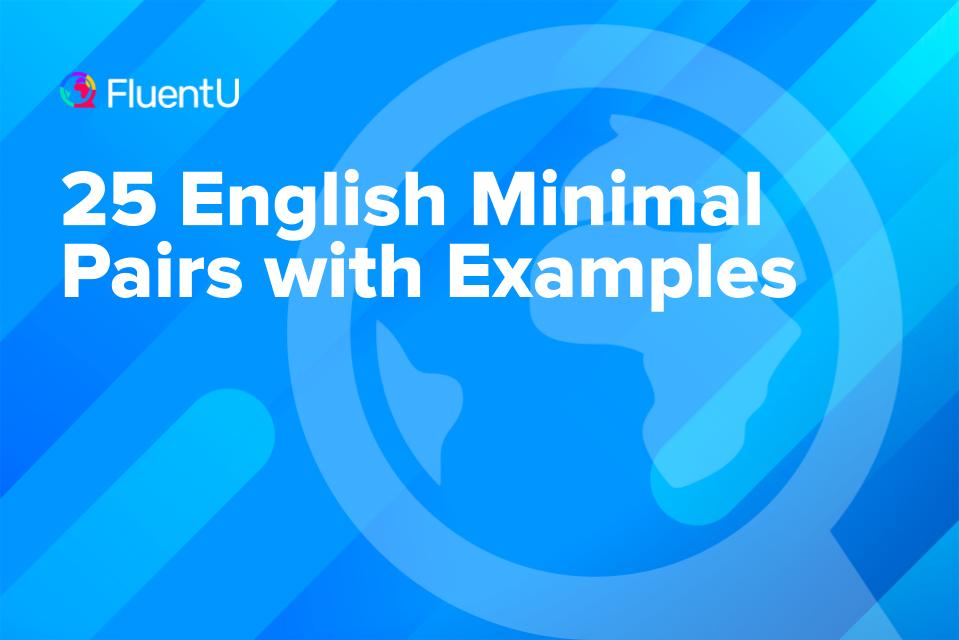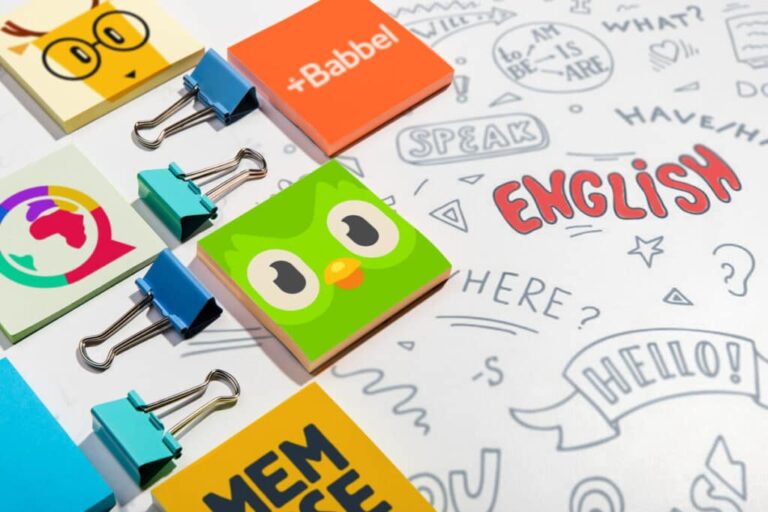25 English Minimal Pairs with Examples

There are a few things you can try to learn English more quickly. One of them is to practice your pronunciation with minimal pairs: Two words that are pronounced almost in the same way.
If you learn minimal pairs, you can really improve your English pronunciation. It’s a great way to become a better English listener and speaker.
Here’s a lesson from our YouTube channel to get you started. You’ll find more minimal pairs in the post below.
Download: This blog post is available as a convenient and portable PDF that you can take anywhere. Click here to get a copy. (Download)
What Are Minimal Pairs?
Minimal pairs are two words that are pronounced almost in the same way, but they have one sound that makes them different. The sound can be a vowel or a consonant.
These pairs have nothing to do with spelling or meaning. The words sound similar but they do not mean the same thing. Their definitions have nothing to do with each other.
They might be spelled very differently, but the actual sounds (called phonemes) will be quite similar. Or, the two words in a minimal pair might be spelled very similarly, with just one different letter.
Minimal Pairs: Vowel Sounds
I vs E sounds
The word lit rhymes with fit or kit. And let sounds more like get. Lit is the past tense of the verb to light. It means to burn something like a candle or a cigarette. Lit can also be used as an adjective, to say that something is full of light such as a room. Let is a synonym of to allow.
I vs EE/EA sounds
Ship refers to a vehicle for water travel, pronounced with a short “i,” while a sheep is a wooly mammal with a long “ee” sound. The biggest difference is that you lengthen the sound in the second word by quite a bit.
In bit, the short “i” sound is similar to the vowel in sit or lid. It means a small piece or amount. In beat, the sound is pronounced as a long “ee,” like in the words beet or deep. It signifies the action of striking rhythmically.
E vs A sounds
The “e” resembles the vowel in hen or end. Meanwhile, the “a” sounds the same as the one in hand. A pen is a thin, small tool used to write and draw. A pan is a circular, flat utensil used to cook food like eggs.
U vs A sounds
The middle sound in cut is pronounced as “uh,” and in cat it sounds like “ah.” To cut is to make an opening or create two or more pieces of something using a sharp tool. A cat is, of course, an animal.
Minimal Pairs: Consonant Sounds
F vs V sounds
In fan, notice how the word starts with the sound “f” which is a quiet sound. In van, the “v” should vibrate and tickle your lips. A fan refers to a device for moving air. Meanwhile, a van is a vehicle for carrying goods or people.
Leaf, referring to the flattened structure of a plant, ends with an “f” sound. The entire word sounds quite short. Leave ends with a “v” sound and means to go away or depart. The word is longer and more drawn out to emphasize the different ending sound.
R vs W sounds
Right starts with the “r” sound, like in rabbit or rain. It refers to something being correct or a direction. White starts with the “w” sound, as in wind or water, and describes a color. In the first word, you use your tongue for the “r,” and in the second, you round your lips for the “w.”
L vs N sounds
The word lot in English is generally used to talk about a large number of things. For example, “I ate a lot of food.” Not is used to refuse or negate something. For example, “I am not well today.”
P vs B sounds
The “p” in pat sounds slightly harder than the “b” in bat. When you say pat, some air will come out of your mouth. When you say bat, this won’t happen.
To pat someone is to lightly touch them with the flat surface of your hand. Bat is usually a long, wooden thing used in sports like cricket or baseball. It is also a kind of animal that flies at night.
Like with pat and bat, you can practice by seeing if air comes out of your mouth when you say pin and not when you say bin.
A pin is a small, sharp metal object used to fasten cloth or paper. A bin is a narrow basket-like object. In British English, a bin is a place where you put trash.
S vs Z sounds
The “s” in sip sounds like the hiss of a snake. The “z” in zip sounds like the buzz of a bee. To sip something is to drink something slowly. Zip as a noun is a short word for zipper, the thing that you use to close your pants or jacket. As a verb, it means to close a zipper.
T vs D sounds
The consonants in the middle (“t” and “d”) make them different in terms of pronunciation. A writer is someone who writes, usually for a living. A rider is someone who rides an animal or a vehicle. The second word is pronounced slightly slower to elongate the sound of the first syllable.
In hat, the last sound is “t,” as in cat or bat, referring to headwear. In had, the last sound is “d,” as in mad or sad, indicating the past tense of “to have.” For the “t” sound, let the air pass over your tongue, and for the “d” sound, block the flow of air for a harder sound.
T vs L sounds
As a verb, tie means to join two things with a knot using a string or rope. As a noun, it refers to the piece of clothing that men usually wear around their neck when dressing formally. To lie is either to say something false, or to be in a horizontal position (such as to lie in bed).
R vs L sounds
The middle sound in both words will help you separate these pairs. Other than the “r” and “l” sounds, these two words sound exactly the same. To arrive is to get to a place. To be alive is to have life.
The end of each word sounds like “oh”. Like the previous pair, the “r” and “l” consonants are what make them different. To grow is to become larger over time. To glow means to shine, or to create light in a dark place.
The “l” and the “r” sounds make these words different, as well as the “w” in the first word! Make sure you add an extra “oo” sound for the first syllable of bowling. Bowling is a sport played with huge balls and pins. Boring means the same thing as uninteresting.
The “k” in kneel is silent, so the first consonants of these words actually sound exactly the same. The last parts of the words are different, though. These parts are pronounced just like the words eel and ear. To kneel is to bend on your knees. Something is near you when it is close to you physically.
S vs TH sounds
The “s” in sigh sounds like the hiss of a snake. And the “th” in thigh sounds like the end of the word tooth. To sigh is to take a deep breath as a sign of sadness, relief or tiredness. The thigh is the part of your leg that is above your knee.
In sin, meaning an immoral act, notice the “s” sound, as in sit or sun. In thin, the first sound is “th,” as in think or thumb, describing something slender. Make sure your tongue is between your teeth for the second sound.
T vs TH sounds
The “t” at the end of tent is a hard “t” sound. The “th” at the end of tenth sounds like the end of the word tooth. A tent is a temporary shelter made from cloth or wood. Tenth can refer to the number ten in a series. For example, the tenth house on a street.
SH vs CH sounds
The “ch” of cheer is pronounced similarly to the “ch” of cherry. The “sh” in sheer sounds like the sound you make to tell somebody to be quiet: shhh!
Sheer refers to a kind of cloth that is so thin you can almost see through it. Cheer is encouraging someone by making loud noises and exaggerated gestures, like at a sporting event.
D vs T sounds
The different sounds of “d” and “t” in these words make them sound different. For the second word, make sure there’s air passing between your tongue and the roof of your mouth for the “t” sound.
If something is hard, it is either physically solid or it is difficult to do. The heart is the organ in our body that constantly pumps our blood.
B vs V sounds
When you say bent, your two lips will come together at the beginning. When you say vent, you will put your upper teeth on your bottom lip.
If something is bent, then it is curved at an angle. A vent can be an opening in a wall that lets gasses pass through a room. The word can be used as a verb, meaning to let out strong emotions.
How to Practice with Minimal Pairs
- Watch a YouTube video to learn the pronunciation of minimal pairs.
- Use a pronunciation dictionary like Forvo to listen to the pronunciation of similar words and try to hear their different sounds.
- Study the sounds on an IPA (International Phonetic Pronunciation) chart.
- Try to identify minimal pairs while listening to people speak English.
If you want to improve your English listening skills, the FluentU language program has English language videos.
FluentU takes authentic videos—like music videos, movie trailers, news and inspiring talks—and turns them into personalized language learning lessons.
You can try FluentU for free for 2 weeks. Check out the website or download the iOS app or Android app.
P.S. Click here to take advantage of our current sale! (Expires at the end of this month.)

We know that separating one word from another in these pairs might feel confusing. In fact, even some native speakers make mistakes while listening or speaking. But if you learn the basics of English pronunciation properly, speaking English actually becomes quite easy.
Noticing how your mouth and tongue move while you speak English words is a great first step. Then, you can learn the different vowel and consonant sounds that exist in English.
You’ll be a master of minimal pairs in no time. Good luck!
Download: This blog post is available as a convenient and portable PDF that you can take anywhere. Click here to get a copy. (Download)
And One More Thing...
If you like learning English through movies and online media, you should also check out FluentU. FluentU lets you learn English from popular talk shows, catchy music videos and funny commercials, as you can see here:
The FluentU app and website makes it really easy to watch English videos. There are captions that are interactive. That means you can tap on any word to see an image, definition, and useful examples.
For example, when you tap on the word "searching," you see this:
Learn all the vocabulary in any video with quizzes. Swipe left or right to see more examples for the word you’re learning.

FluentU helps you learn fast with useful questions and multiple examples. Learn more.
The best part? FluentU remembers the vocabulary that you’re learning. It gives you extra practice with difficult words—and reminds you when it’s time to review what you’ve learned. You have a truly personalized experience.
Start using the FluentU website on your computer or tablet or, better yet, download the FluentU app from the iTunes or Google Play store. Click here to take advantage of our current sale! (Expires at the end of this month.)










